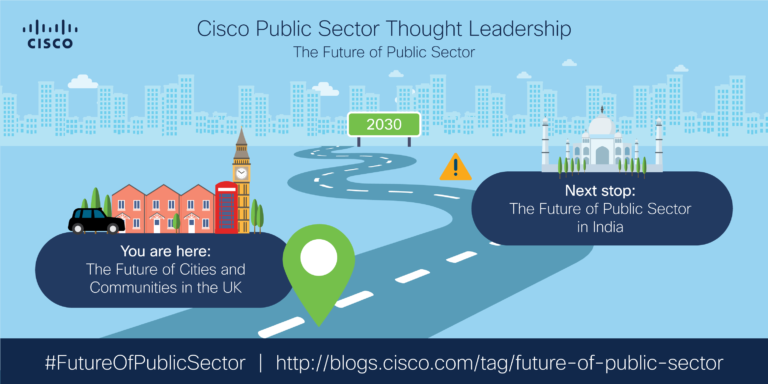As we continue our trip around the world for the #FutureofPublicSector, let’s hop over the pond to the United Kingdom to dream about the future of cities and how they will better provide for and focus on their citizens.
Introduction to the Cities and Towns of the UK
What is a city?
I quite like this definition from Wikipedia:
“A city is a large human settlement. It can be defined as a permanent and densely settled place with administratively defined boundaries … Cities generally have extensive systems for housing, transportation, sanitation, utilities, land use, and communication. Their density facilitates interaction between people, government organisations and businesses, sometimes benefiting different parties in the process.”
In that “human settlement,” years upon years of history pass. Lives are spent in dedication to governing and transforming the “permanent and densely settled place.” Population ebbs and flows, and families and citizens move in and out in search of better lives.
The first cities appeared nearly 6,000 years ago. In the millennia since, the ways that we see the city, the town, and the community – the ways we live in those places and the ways they serve their citizens – have all been in constant evolution.

Thinking about cities and towns as communities
Interestingly, the word “city” and the related “civilization” come from the Latin root civitas, originally meaning citizenship or community member. So, from the beginning, a city and a community have been synonymous!
In the United Kingdom, our cities and towns have been evolving for hundreds of years. Think of the city of London, founded in 43 C.E., which holds the legacy of the Romans and every population since. Our cities have been around a long time and they will be around for a long time to come: this makes it critical to look to the future.
As we plan our “smart cities,” we must ask:
“How can we make a community more efficient and provide better services for everyone who calls that place home?”
The way we plan cannot be for today alone. The investments we make must take into account the past: the infrastructure and foundations upon which we will build, and prepare for the future: the technologies that will arise and the new challenges we will face.

The “Snowflake Approach“
As we build tomorrow’s cities, there is no one size fits all approach. Like a snowflake, each community is unique. Ask fifteen people in different places what smart solutions can do for them and you’ll receive fifteen different answers. We need to have an approach that is scalable, but tailored to the unique challenges of any given place. Problems, large and small, need local solutions.
When looking at the town of Southend-on-Sea and the city of Manchester, one can see that they have very different needs. So, how can we tailor the way we approach “smart cities” to the specific needs of the people who live there?
Those needs encompass the whole society: from air pollution to congestion to healthcare and education and helping the underserved populations who are often left behind.

Building cities for citizens
As a father, I want to be able to take my daughter down any street in the United Kingdom, at any time of day or night – and know we will be safe. I want her to breathe in clean air. I want her to be able to have a high-quality education and – if she needs it – to have access to the best in healthcare. That is what a smart city must aim to provide. We are building the city of tomorrow for her, for her generation and the ones that follow. That is why we have to get this right.
The future is about people. And the future is about outcomes. To serve people, we must decipher how to measure societal impacts within that one community, that one town or village or city.
And the best people to identify the challenges faced by a community are those that live there. Community leaders, citizens, academics and private sector organisations all have a part to play in facing and addressing these challenges.
Smart Streets and a Smart City in Newcastle-Upon-Tyne
Once, it was the first city in the world to have a street with electric lighting. Today, Newcastle is firmly grounded in the present, with its eyes turned to the future. From creating the smartest streets in the UK on what were once the first electrically lit streets, to pinpointing patterns and problems through Newcastle University’s Urban Observatory, to reducing traffic and pollution and even implementing AI through Cisco technology, Newcastle-Upon-Tyne shows what can happen when we implement local solutions to target their challenges. In recognition for their game-changing transformation, in 2019, they were named the ‘Smart City of the Year.’
Creating the communities of tomorrow
We all live, work, study and play somewhere. That is our home – that is our city or our community. As we build the connected places of tomorrow, we must take into account the urban and rural communities of today and the people who live in them.

We’d love to hear your thoughts on the United Kingdom’s future of cities and communities. How is your country preparing for a digital future? Comment below and stay tuned for the next installment of our #FutureofPublicSector series on the Future of Public Sector in India.




Wow! Hugely impressive and informative blog. This blogger exudes confidence and belief in his work. It is clear, by actually delivering real solutions and outcomes Cisco are building a portfolio of expertise for how we might live in the future, second to none.
I look forward to learning from future blogs. I was touched by the reference to his own life and ambition to deliver a better future for his family, the community he serves and others. For a young person like myself, its good to know, my future is in safe hands. An enviable and worthy blog. Thank you.
Thank you Remy for your very positive comments.
At the end of the day, for me, this is all about all our families and friends and the future we create together. This has to be a future where everyone benefits from the amazing things we can do by using technology for good, not just technology for technologies sake.
Cities have been smart for a very long time (just look at what the Chinese, Egyptians, Mayans, Romans etc etc) all did 100’s or 1000’s of years ago. Now it’s our turn to use the technology available to us to make things better.